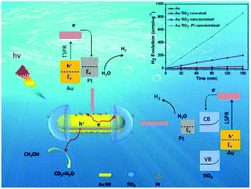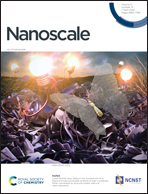Strategic modulation of energy transfer in Au-TiO2-Pt nanodumbbells: plasmon-enhanced hydrogen evolution reaction†
Abstract
Owing to the capacity of efficiently harvesting and converting incident energy, localized surface-plasmon resonance of noble metals was introduced into a metal–semiconductor design for promoting hydrogen evolution. In this study, a plasmonic nanodumbbell structure was employed to strategically modulate the energy transfer in the water reduction reaction. A maximum H2 evolution rate of 80 μmol g−1 h−1 was obtained in the Au-TiO2 nanodumbbells, and further improvement was achieved through surface modification with Pt nanoparticles functioning as active sites, leading to ∼4.3 times enhanced photocatalytic activity. Compared with similar nanostructures reported previously, the present superior photoactivity response is ascribed to the injection process of the energetic hot electrons generated from the excitation and decay of the longitudinal surface-plasmon resonance (LSPR) and transverse surface-plasmon resonance (TSPR) in the Au nanorods, which corresponds to the electric field distribution of the finite-difference-time-domain simulation. These intriguing results, originating from the positive synergistic effect of the plasmon and co-catalyst, demonstrated the mechanism of the plasmon-assisted photochemistry and provided a promising strategy for the rational design of novel plasmonic photocatalysts.

- This article is part of the themed collection: 2020 Nanoscale HOT Article Collection


 Please wait while we load your content...
Please wait while we load your content...